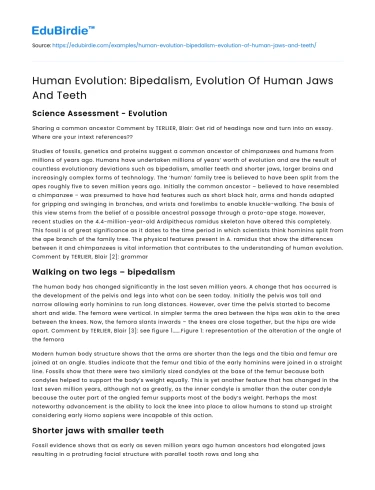Science Assessment - Evolution
Sharing a common ancestor Comment by TERLIER, Blair: Get rid of headings now and turn into an essay. Where are your intext references??
Studies of fossils, genetics and proteins suggest a common ancestor of chimpanzees and humans from millions of years ago. Humans have undertaken millions of years’ worth of evolution and are the result of countless evolutionary deviations such as bipedalism, smaller teeth and shorter jaws, larger brains and increasingly complex forms of technology. The ‘human’ family tree is believed to have been split from the apes roughly five to seven million years ago. Initially the common ancestor – believed to have resembled a chimpanzee – was presumed to have had features such as short black hair, arms and hands adapted for gripping and swinging in branches, and wrists and forelimbs to enable knuckle-walking. The basis of this view stems from the belief of a possible ancestral passage through a proto-ape stage. However, recent studies on the 4.4-million-year-old Ardipithecus ramidus skeleton have altered this completely. This fossil is of great significance as it dates to the time period in which scientists think hominins split from the ape branch of the family tree. The physical features present in A. ramidus that show the differences between it and chimpanzees is vital information that contributes to the understanding of human evolution. Comment by TERLIER, Blair [2]: grammar
Walking on two legs – bipedalism
The human body has changed significantly in the last seven million years. A change that has occurred is the development of the pelvis and legs into what can be seen today. Initially the pelvis was tall and narrow allowing early hominins to run long distances. However, over time the pelvis started to become short and wide. The femora were vertical. In simpler terms the area between the hips was akin to the area between the knees. Now, the femora slants inwards – the knees are close together, but the hips are wide apart. Comment by TERLIER, Blair [3]: see figure 1…….Figure 1: representation of the alteration of the angle of the femora
Modern human body structure shows that the arms are shorter than the legs and the tibia and femur are joined at an angle. Studies indicate that the femur and tibia of the early hominins were joined in a straight line. Fossils show that there were two similarly sized condyles at the base of the femur because both condyles helped to support the body’s weight equally. This is yet another feature that has changed in the last seven million years, although not as greatly, as the inner condyle is smaller than the outer condyle because the outer part of the angled femur supports most of the body’s weight. Perhaps the most noteworthy advancement is the ability to lock the knee into place to allow humans to stand up straight considering early Homo sapiens were incapable of this action.
Shorter jaws with smaller teeth
Fossil evidence shows that as early as seven million years ago human ancestors had elongated jaws resulting in a protruding facial structure with parallel tooth rows and long sharp canines. The first signs of changes in the structures of both the jaws and teeth of Homo sapiens occurred roughly 5.5 million years ago when the canines began to grow smaller. 3.5 million years ago the teeth began to form rows that were a little further apart towards the back than the front. 1.8 million years ago the canines became shorter and more blunt – similar to current human teeth- and the jaw became considerably shorter causing the facial structure to become more vertical and the rows of teeth to curve into an arc. The most recent development took place 250, 000 years ago when direct human ancestors had short jaws and pointed chins - opposed to not having one at all - for extra strength. To fit the new shape of the jaws the teeth had to become smaller and more tightly packed. This development lead to modern human’s having vertical facial structures rather than protruding facial structures. Comment by TERLIER, Blair [4]: grammar Comment by TERLIER, Blair [5]: grammar
Figure 2: evolution of human jaws and teeth over several million years
Figure 2 shows that early humans had incisors that were large in comparison to the smaller ones associated with modern humans. The incisors on the upper jaw were quite broad and projected outward whereas they are now narrow and moderately vertical. Contemporary Homo sapiens have rather short blunt canines that do not vary much in size between males and females. However, the canines were initially long and pointed, being bigger in males than females. Molars were large. Now, molars have reduced in size and become more wedged in the jaw. Premolars had tall bumps on the grinding surface. Presently, molars and premolars are rather level with small, round bumps on the grinding surface. Seven million years ago teeth were coated by a thin layer of enamel. However, they are now coated by a much thicker layer of enamel.
https://www.livescience.com/474-controversy-evolution-works.html
Darwin’s theory (survival of the fittest)
Charles Robert Darwin’s was a biologist, geologist and naturalist. Darwin was known for his involvement in the science of evolution of which he had developed his own theory. Darwin’s theory of evolution is survival of the fittest. His theory relies on evidence from several different sciences such as palaeontology, genetics, geology and developmental biology. When Darwin was investigating his theory he did not have access to the types of modern technology that currently exist. This meant that he had to rely solely on his own observations.






 Stuck on your essay?
Stuck on your essay?

